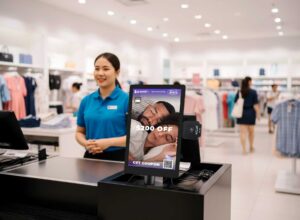Brick-and-mortar retailers and e-commerce companies are in the midst of a game of one-upmanship, a battle that features each side vying for a larger slice of the customer loyalty pie. The tactics used in the back and forth are aimed at making the shopping experience that much more convenient for buyers than it is already. Mobile POS systems are one of the strategies that physically located stores have implemented with great success.
But the latest place in which the tit-for-tat is taking place is the grocery aisle. In these “grocery wars,” entities like Amazon and meal-kit company HelloFresh don’t just offer the items families purchase at their local markets, but they deliver them right to shoppers’ front doors so buyers never have to leave the comfort of home.
 Nearly 50 percent of Americans have either researched or bought grocery items online.
Nearly 50 percent of Americans have either researched or bought grocery items online.
While it’s still relatively early in these turf wars, it’s clear that brick-and-mortar grocery chains are taking the contest seriously with strategies of their own.
Phil Lempert, an independent foot retail analyst, told The Washington Post that grocers have no choice but to fight back.
“I think we’re going to see a lot of chains [close],” Lempert warned. “There are some retailers who have innovated and stayed ahead of the trends. But they have been the exception.”
One of the chains that fell short in mounting an effective counterattack is Tops. A 56-year-old grocer with 169 locations based in Vermont, New York and Pennsylvania, Tops filed for bankruptcy this past February, unable to get out from under mounting debt, the Post reported. Other food retailers that have struggled since Amazon purchased Whole Foods include Winn-Dixie, Harvey’s and Bi-Lo, grocers mainly located in the southeastern portion of the U.S.
Kroger, Alibaba form allegiance
Determined not to suffer a similar fate, Kroger has upped its tech game to better contend with the inroads established by e-commerce entities. This past summer, Kroger partnered with Hangzhou China-based multinational corporation Alibaba, a venture that will find the chain selling organic foods, supplements and staple products like nuts to customers in the world’s most-populated country, Reuters reported.
Yael Cosse, chief digital officer at Kroger, noted in a statement that the partnership will help Kroger reach more customers than it would otherwise, thanks primarily to online capabilities.
“E-commerce enables Kroger to quickly scale (up) to reach new customers and markets where we don’t operate physical stores, starting with China,” Cosse explained.
“28% shopped at online-only food stores this year, up from 16% in 2015.”
Kroger’s gambit into the online space comes as brick-and-mortar grocers learn that shopping for food via the internet is no mere passing fad. Indeed, according to the Food Marketing Institute, nearly 50 percent of Americans have either researched or bought grocery items online. What’s more, in 2018, approximately 28 percent of respondents acknowledged shopping at online-only food stores, up from 16 percent in 2015. Leading the movement are Millennials, with 40 percent of 18- to 38-year-olds scanning digital aisles in the past year, compared to around 30 percent of Generation Xers.
Scott Galloway, an author and marketing professor at New York University, said Kroger’s partnership is a smart one because Alibaba possesses what Kroger doesn’t – an influential online presence.
“I think this would involve two things, technology and capital, which Alibaba has in spades,” Galloway told Foodable Network. “Kroger has scant technology and relative to Amazon has scant capital.”
Walmart partners with Deliv
Walmart has also implemented an “if you can’t beat ’em, join ’em” game plan by forging partnerships with Deliv, a retail startup that’s based in San Mateo, California. Reported by Silicon Valley Business Journal, the collaboration formed late last year and enables customers to shop online for the foods they want. Launched first at select locations in the Golden State, the initiative allows consumers to shop, select and buy online from 8 a.m to 8 p.m. and arrange for home delivery by a Deliv driver.
Sylvester John, Walmart senior director of e-commerce, indicated that the move was a no-brainer for the company, given its interactions with Deliv in the past.
“After working with Deliv on other initiatives, we know they share our obsession with customer service and recognize the need to provide unparalleled value and convenience to our shared customers,” John said, as quoted by the business news publication.
The discount department conglomerate expects 25 percent of its grocery sales to be internet-based come 2025. Overall, online sales represent about 5 percent of all grocery sales in the U.S., according to The Wall Street Journal.



